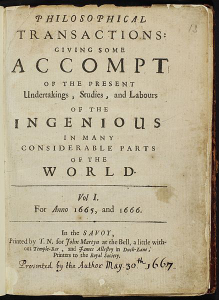By Ernesto Spinak and Abel L Packer
Scientific journals complete 350 years since the appearance of the Journal des Sçavans and Philosophical Transactions. Over these years journals became the primary means of communication of scientific research results. They monitor and record the progress of science, especially from the mid-twentieth century. Altogether they are the main dynamic memory of the advancement of scientific knowledge. Its production in periodic series conform scientific information flows in different disciplines and subject areas that inform researchers on the progress in their areas of interest.
These information flows reported by journals are controlled by the bibliographic indexes that record the new communications and interactions with ideas and previously published data. These indices are an indispensable source for scientific update and an important source of monitoring and performance ranking of research, research groups, institutions, subject areas, countries and, of course, the journals. In short, journals are an integral part of the infrastructure of science.
There are different estimates of the number of scientific journals. The Ulrich’s index records more than 70,000 “refereed/peer-reviewed” journals, of which over 50,000 are published online. In May 2014 the Portal de Periódicos CAPES gave access to more than 37,000 scientific journals in full text. The WoS index covers more than 13,000 journals, Scopus over 20,000, and SciELO over a thousand.
With the emergence of the Web and its consolidation in the last two and a half decades as the primary means of exchange of mankind’s information, the online publication also started to be the main means of scientific communication. Due to the facilities in information and communication technologies, journals and bibliographic indexes were renewed and many innovations are ongoing. The online availability and interoperability have been the major advances besides the emergence of open access, the continued publication of articles as they are approved by the editorial committees, the megajournals and the strengthening of the visibility of journals of emerging and developing countries by programs and networks such as SciELO and the like.
Communication among scientists was accelerated by the Web and the support systems to social networks. In many cases direct communication resembles the letters between scientists which preceded the appearance of journals. For the story began 350 years ago, through communications and letters between the “communauté de savants” or “community of scholars”. Let’s recap a little history.
In the late Middle Ages scientific knowledge was a huge corpus built over centuries by the admirable effort of scholars who tried to synthesize Aristotelian philosophy with Christian tradition. In the early modern era and reaching the seventeenth century, we find a number of important names who are committed to establishing this scientific knowledge on a firmer background.
Just to mention a few, we have Francis Bacon, Galileo, Descartes, Robert Boele, Spinoza, Leibniz, Newton and many others who were involved in the search for a common core of wisdom, that is, a philosophical core in which knowledge could base, which would allow them to face the philosophical tradition they received. They sought new avenues to reach the unity of knowledge under a new paradigm, which included the trial and subsequent reporting of results to colleagues, in the format of letters in the beginning and later, due to the press, it was possible to broadly widespread them.
Then, in 1665, it’s been 350 years, and only 60 days apart, emerged in different ways, on the one side and on the other side of the English Channel, the first two “scientific publications”, which preceded the current. These publications were the Journal des Sçavans and the Philosophical Transactions, later renamed to Journal des Savants and Philosophical Transactions of the Royal Society, respectively.
On January 5, 1665 it was published in Paris the first issue of the Journal des Sçavans, under the sponsorship of private lawyer and member of the vestment Denis Sallo, Sieur de a Coudraye supported by Jean-Baptiste Colbert, Minister of Economy, who two years later founded the Académie Royale des Sciences (December 1666).
The Journal des Sçavans proclaimed from the beginning its ambition to spread news about the books and the people of “République des lettres,” which not only included scientific research as we know it, as well as intensive discussions on the Cartesian philosophy, filling all areas of thought in this century, both for and against. Descartes was the subject of scholarly talks in Paris and the provinces, and for more than 50 years there was not a single book published in France that did not have a philosophical discussion with Descartes as an object.
The Journal des Sçavans imposed a new writing style and ways to disseminate scientific knowledge, indicating its five goals in the first issue:
- The editor announced that he shall inform readers about the new books published in Europe, not only in lists of titles, but also comments and brief descriptions of the contents.
- Obituaries of famous people including their bibliographies.
- Communication of experiments and discoveries in physics and chemistry to explain the phenomena of nature, astronomical observations, useful machines and anatomical descriptions of animals.
- Decisions on religious and secular courts, as well as the edicts of censorship.
- In general, “there is nothing that occurs in Europe worth be known by men of letters that you cannot learn from this Journal”
The scope of the Journal des Sçavans, in general, was to inform about everything that was happening in the community of “savants“, as well as the communication of reports from different genres, which shows that the philosophical framework expressed by the Journal is much more broader than pure Cartesianism, and that this is only one of its philosophical ingredients, but that transcends it.
Philosophical Transactions, the other journal, was founded just two months later, on March 6, 1665, and was born and developed with a different history.
The Royal Society was founded in London in 1662, one of his two secretaries was Henry Oldenburg, a German philosopher regarded as one of Europe’s eminences in his time. Oldenburg had the task of maintaining an extensive network of scientific correspondence. Members of the Royal Society gathered periodically to hear the reading of these letters, and it was Oldenburg’s responsibility to inform members who could not attend the meeting on the content of the letters. So Oldenburg began printing these letters to disseminate information to associates and looking for a way to systematize the task (and also earning some money), he began to print a newsletter… which gave origin to the journal.
The Philosophical Transactions compared to the Journal des Sçavans (with its five ambitious objectives), covered a smaller range of topics, especially those who could today be considered “scientific”, and relatively few book reviews.
Then there began a story that in these weeks is completing 350 years. Today both journals are still published, but Journal des Sçavans is more oriented to the literary context than the scientific. Since February 2014, the Journal des Sçavans is available online at the Bibliothèque Nationale de France Gallica digital library.
As a final thought we could add that, from the very beginning of the journals, there was a consensus among researchers and scholars that the findings should be disseminated and presented openly to review by their peers. The “peer review” is as old as scientific journals, and in addition, it is interesting to note that at that time, arbitration was not an anonymous or blind process, but open to all colleagues, a kind of peer review and Open Access.
References
ALEXANDRESCU, V. Branching Off: The Early Moderns in Quest for the Unity of Knowledge (Foundations of Modern Thought). 2009.
BANKS, D. Starting science in the vernacular. Notes on some early issues of the Philosophical Transactions and the Journal des Sçavans, 1665-1700. ASp [Online]. 2009, vol. 55. [viewed 24 February 2015]. DOI: 10.4000/asp.213
DOBRE, M. Early Cartesianism and the Journal des Sçavans, 1665–1671. Studium: Revued’Histoire des Sciences et des Universités. 2012, vol. 4, nº 4, pp. 228-240. [viewed 24 February 2015]. Available from: http://www.gewina-studium.nl/index.php/studium/article/view/1557/1594
Journal des savants. Wikipedia. [viewed 24 February 2015]. Available from: http://fr.wikipedia.org/wiki/Journal_des_savants
NORMAN, J. Journal des sçavans: The First Scientific Journal Begins Publication (January 5 1665). History of Information.com. [viewed 24 February 2015]. Available from: http://www.historyofinformation.com/expanded.php?id=2661
Philosophical Transactions of the Royal Society. Wikipedia. [viewed 24 February 2015]. Available from: http://en.wikipedia.org/wiki/Philosophical_Transactions_of_the_Royal_Society
External Link
Bibliothèque Nationale de France Gallica digital library – <http://gallica.bnf.fr/ark:/12148/cb343488023/date.r=journal+des+scavans.langEN>
 About Ernesto Spinak
About Ernesto Spinak
Collaborator on the SciELO program, a Systems Engineer with a Bachelor’s degree in Library Science, and a Diploma of Advanced Studies from the Universitat Oberta de Catalunya (Barcelona, Spain) and a Master’s in “Sociedad de la Información” (Information Society) from the same university. Currently has a consulting company that provides services in information projects to 14 government institutions and universities in Uruguay.
Como citar este post [ISO 690/2010]:

















Pingback: CEVAP Journal: the first Brazilian electronic scientific publication turns 20 years old